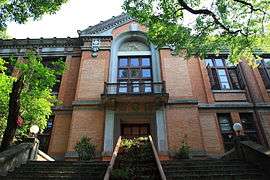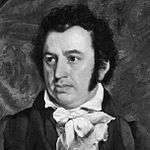Hangchow University Historic Site is a major nationally-protected historic site of the People's Republic of China located in Hangzhou.[1]
Introduction
The site is located in Hangzhou City, Zhejiang Province, and close to the Qiantang River and the Liuhe Pagoda. It currently located in (and is a part of) the Zhijiang Campus of Zhejiang University, and the university manages its daily operation. The site has very beautiful landscapes and architectures. It became a national key historic site mainly due to its precious architectures of the Republic of China Era (1912 - 1949), which has a special combination of both the Western and Chinese architectural styles.
Brief history
The Hangchow University (it's a different concept from the later Hangzhou University, and the Hangchow is the old English translational form for the present Hangzhou) was also a root of current modern Zhejiang University. It was one of the thirteen most well-known Protestant universities in China's modern history before 1951.
The history of Hangchow University can be traced back to 1845. A [minister] named Divie Bethune McCartee of American Presbyterians (North, PN) first founded the Ningpo Boy’s Academy / Boarding School (simplified Chinese: 崇信义塾; traditional Chinese: 崇信義塾; pinyin: Chóng xìnyì shú; literally: "Public School of Esteeming Faith"; Ningpo stands for present Ningbo) in Ningbo, Zhejiang Province. 1867, the school was moved into Hangzhou and changed its name into Hangchow Presbyterian Boys' School (simplified Chinese: 育英义塾; traditional Chinese: 育英義塾; pinyin: Yùyīng yìshú; literally: "Public School for Educating Elites").
1897, the school opened courses for higher education, and became a college, named Hangchow Presbyterian College (simplified Chinese: 育英书院; traditional Chinese: 育英書院). 1914, its name was changed into Hangchow Christian College (simplified Chinese: 之江大学; traditional Chinese: 之江大學). 1909, the Presbyterian Church in the United States also participated in the college's daily operation. During the Northern Expedition (1926–1927) period, the college was ceased for a while. 1931, the government renamed the college as the (Private) Hangchow College of Sciences and Humanities (simplified Chinese: 私立之江文理学院; traditional Chinese: 私立之江文理學院), because the college itself only had two branches - science and literature, at that time. During the Second Sino-Japanese War, the college moved through numerous places to avoid the Japanese invasion and military campaign, including Tunxi (in current Anhui Province), Shanghai, Shaowu (in current Fujian Province), Guiyang (the capital city of Guizhou Province), Chongqing (the war-period capital of China), etc. 1948, the college had two more faculties of engineering and business (business school), and was promoted into the university status, named Hangchow University (simplified Chinese: 之江大学; traditional Chinese: 之江大學).
After setting up of the People's Republic of China, in 1951, the university was handed over to the Zhejiang Provincial Government, and all the American teachers were sent back to United States. 1952, the Adjustment for University Colleges and Departments (simplified Chinese: 中国高校院系调整; traditional Chinese: 中國高校院系調整) started, and the most part of Hangchow University was merged into the Zhejiang University.[2]
Schools and Departments
- Faculty of Arts
- Faculty of Engineering
- Faculty of Business
Notable alumni
- Chen Congzhou (simplified Chinese: 陈从周; traditional Chinese: 陳從周; pinyin: Chén Cóngzhōu; born 1918) architect.
- Jin Zhonghua (simplified Chinese: 金仲华; traditional Chinese: 金仲華; pinyin: Jīn Zhònghuá), politician.
- Lin Zuodi (Chinese: 林作砥; pinyin: Lín Zuòdǐ), a academician of National Academy of Engineering.
- Mei Shaowu (simplified Chinese: 梅绍武; traditional Chinese: 梅紹武; pinyin: Meí Shàowǔ), translator.
- Qijun (Chinese: 琦君; pinyin: Qí Jūn; 1917 - 2006), writer.
- Yang Sixin (simplified Chinese: 杨嗣信; traditional Chinese: 楊嗣信; pinyin: Yáng Sìxīn; born 1930) architect.
- Zhang Wencai (Chinese: 章文才; pinyin: Zhāng Wéncaí), biologist.
- Zhu Shenghao (Chinese: 朱生豪; pinyin: Zhū Shēngháo), translator.
Principal
- Rev, J H Judson (Chinese: 裘德生; pinyin: Qiú Déshēng), President of Hangchow Presbyterian College
- E. J. Mattox (simplified Chinese: 王令庚; traditional Chinese: 王令賡; pinyin: Wáng Lìnggēng), President of Hangchow Christian College 1914 to 1916.
- Robert Fitch (simplified Chinese: 司徒华林; traditional Chinese: 司徒華林; pinyin: Sītú Huálíng), President of Hangchow Christian College 1916 to 1922.
- Baen E. Lee (Chinese: 李培恩; pinyin: Lǐ Peí'ēn), President of Hangchow University 1931 to 1949.
- Li Zhaohuan (simplified Chinese: 李照寰; traditional Chinese: 黎照寰; pinyin: Lǐ Zhàohuán), President of Hangchow University 1949 to 1952.
See also
References
|
|---|
|
| Schools & Colleges | |
|---|
|
| Affiliations | |
|---|
|
| University Hospitals | |
|---|
|
| Centers & Institutes | |
|---|
|
| Historic Sites | |
|---|
|
| Natural Beauties | |
|---|
|
| Campuses | |
|---|
|
| History | |
|---|
|
| People | |
|---|
|
| Student Life | |
|---|
|
| Foundations | |
|---|
|
|
Protestant missions to China |
|---|
|
| Background | | |
|---|
|
| People | |
|---|
|
| Missionary agencies | |
|---|
|
| Impact | |
|---|
|
| Pivotal events | |
|---|
|
| Chinese Protestants | |
|---|
Coordinates: 30°11′41″N 10°07′16″E / 30.19472°N 10.12111°E / 30.19472; 10.12111






